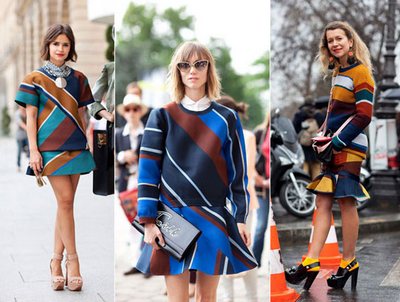
Street style icons Elena Perminova, Michelle Harper, Natalie Joos, Miroslava Duma, Anya Ziourova, Anna Dello Russo and Giovanna Battaglia shot by Tommy Ton (image via style.com)
In the age of technology and social media, when everyone has the capacity to report, consume and share news, street fashion is steadily gaining impact. Both traditional and online publications are quick to cater to their readers’ insatiable hunger for real-time information. So we’re consuming a constant stream of images and posts documenting the tiniest details of major fashion and cultural events.
And with the rising popularity of blogging, what people wear as they are going about their lives has started to interest us no less than what designers send down the catwalk, creating a special caste of street style icons. Photographed by the likes of Tommy Ton and Scott Schuman street style personalities are perceived as more genuine, accessible and relatable than runway models. That is why Leandra Medine (aka The Man Repeller), Natalie Joos (Casting Director and blogger), Susanna Lau (of Style Bubble) and other popular fashionistas have a huge following that is swayed by their wardrobe choices. In fact, street style icons’ power has become so great, that it allows them to launch trends and propel budding designers to fame.

Miroslava Duma, Anya Ziorova and Natalie Joos wearing Ostwald Helgason (image via harpersbazaar.com)
Consider the case of Ostwald Helgason, a young London-based brand that got their break in 2012. When Evelien Joos cast the label’s fall show, her sister Natalie couldn’t resist borrowing one of the outfits to wear at Paris Fashion Week. Miroslava Duma (Fashion Consultant, Founder of Buro 24/7) and Anya Ziourova (Fashion Director of Tatler Russia and Allure Russia) noticed Natalie’s look and followed suit by buying and wearing Ostwald Helgason pieces themselves, thus, helping the label rise to prominence first through street style photography blogs, and later through traditional media. Susanne Ostwald and Ingvar Helgason claim that:
“For us, as a small brand, we would never be able to get that kind of exposure [otherwise].”
Aside from promoting their sartorial creations, street style helps designers see how their garments are appropriated into real life situations, how they are mixed and matched with other brands, providing valuable feedback that allows labels to identify their hits and misses, as well as get inspired for new collections.

Anna Dello Russo is often criticized for "peacocking" (image via laurenoutloud.com, part of "TAKE MY PICTURE" documentary by GARAGE Magazine)
But there’s a different side to the story. Suzy Menkes called what is happening outside Lincoln Center and in the Tuileries Garden a circus, criticizing the phenomenon of “peacocking” – dressing in wacky outfits to be shot by street fashion photographers. And one can’t argue that she has a point in doubting the motifs that guide street style stars’ behavior. Because it really seems that the ever-increasing number fashion bloggers, magazine editors, fashion insiders and people who are famous for no particular reason at all turn to “peacocking” to satisfy their craving for attention. Besides, some newly minted street style personas deliberately wear outrageous garment combinations in hopes of getting on the designers’ radar, landing requests for collaboration, and receiving luxurious gifts which they could show off during the next major fashion event.
Should designers team up with street style icons to promote their commercial goals? Much like soliciting celebrity endorsements, it all depends on your brand’s personality and message. Since each street fashion star has their own style and a distinct set of followers, it only makes sense to reach out to someone who belongs to or directly influences your target audience (that is, if you’re aiming to land a product review or get increased media exposure).


About The Author: BridgeShowroom
Ken Nachbar is a co-founder and partner in Bridge Showroom. Ken loves working with designers, helping them open new doors, find new customers, and grow their businesses. With bachelor's degree in economics and an MBA from the University of Michigan, Ken combines 25 years of management skill and experience with his passion for fashion.
More posts by BridgeShowroom